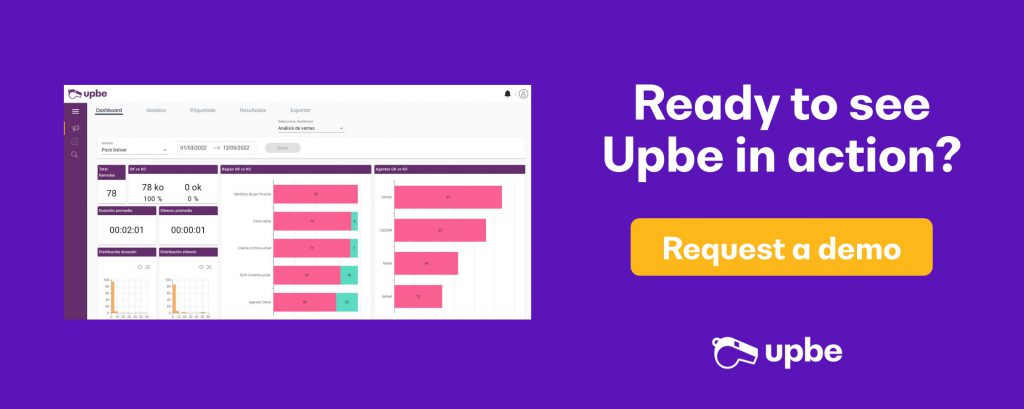
In the world of call centers, service quality is essential to ensure customer satisfaction and the success of the company. To measure and improve this quality, it is crucial to have key performance indicators, known as KPIs. These KPIs provide valuable insights into the performance and efficiency of a call center, enabling the identification of areas for improvement and the optimization of the customer experience.
However, KPI analysis is not limited to call center agents alone. It is also important to evaluate and measure the performance of quality control analysts, who play a crucial role in the continuous improvement of customer service. While their role is to monitor the work of agents, quality control analysts can also make mistakes and require growth through experience. This is where KPI metrics come into play.
In this text, we will explore the key KPIs for analyzing quality in call centers, both for agents and quality control analysts. We will discover how to effectively apply these KPIs to drive efficiency, quality, and satisfaction in such a complex environment as a call center.
What are the KPIs of a call center?
KPIs in a call center play a fundamental role in performance evaluation and decision-making. In this industry, indicators acquire even greater relevance due to two specific challenges faced by decision-makers.
The first challenge is the reduction of uncertainty caused by the variability in call demand, which makes workforce planning and team sizing more difficult.
The second challenge is the balance between costs and quality. Each handled call involves both revenue and costs, so missing calls means losing opportunities and money. In an industry with tight margins, it is essential to improve productivity, efficiency, and quality to achieve a significant impact.
In this delicate balance, the goal is to maximize the number of handled calls, provide quality service, determine the right amount of agents, all within a set timeframe. KPIs are essential tools for addressing these challenges and making informed decisions.
The 11 key KPIs for call center quality analysis
1. Customer Satisfaction (CSAT)
CSAT is a KPI used to measure the level of customer satisfaction with the service provided in a call center. It is obtained by directly soliciting feedback from customers, who rate their experience and may provide additional comments.
By sending CSAT surveys immediately after a call, it is possible to obtain immediate feedback and assess agent performance based on CSAT scores. CSAT is typically measured on a scale of 1 to 10, where 1 represents total dissatisfaction and 10 represents maximum satisfaction.
2. Average Abandonment Rate (AR)
The Abandonment Rate (AR) measures the percentage of calls that are abandoned before reaching an agent in a call center.
Formula: Abandonment Rate = (Total abandoned calls / Total incoming calls) * 100
A high abandonment rate can indicate issues with call routing or insufficient resources. Maintaining a low abandonment rate is crucial for providing a good customer experience.
3. Net Promoter Score (NPS)
The Net Promoter Score (NPS) is a popular metric that helps measure customer satisfaction and their willingness to recommend a company.
Customers complete a survey where they are asked about the likelihood of recommending the company to friends or family. Responses are measured on a scale from 1 to 10, where 0 is “not at all likely” and 10 is “extremely likely.” The higher the score, the more likely customers are to recommend the company.
A higher NPS implies greater word-of-mouth promotion. NPS is an indicator of customer loyalty and the strength of relationships with them, and one way to measure it is through the likelihood of recommendation to colleagues or friends.
4. Customer Effort Score (CES)
The Customer Effort Score (CES) is a metric that evaluates the ease or difficulty a customer experiences when interacting with a company in a call center. CES is based on the amount of effort the customer needs to invest to resolve an issue or answer a question.
This indicator is measured through satisfaction surveys, offering customers the opportunity to respond on a scale from 1 to 7, where 1 is “very difficult” and 7 is “very easy.”
Factors such as call transfers, repeated information, and channel switching can increase the customer effort level. Reducing customer effort involves actions such as minimizing transfers, improving problem resolution, and providing better and efficient customer service.
5. First Contact Resolution (FCR)
First Contact Resolution (FCR) is a KPI that measures a call center’s ability to resolve customer issues on the first contact, without the need for callbacks or follow-ups. It is an important indicator of customer service efficiency and quality.
Formula: FCR = (Cases resolved on first contact / Total cases) * 100
A high FCR indicates that agents are able to effectively resolve customer inquiries and issues, leading to higher customer satisfaction and cost savings by avoiding additional interactions.
6. Average Handling Time (AHT)
AHT, or Average Handling Time, is the amount of time an agent in a call center spends on a call, from the moment they answer until they disconnect.
Formula: AHT = [(Talk time + hold time + after-call time) / total number of calls] * 100
While it’s important to have a low AHT to improve call center efficiency, it is also crucial to achieve satisfactory resolution for the customer. The goal is not simply to end the call quickly, but to effectively solve the customer’s problem. A low AHT but with low customer satisfaction can be detrimental to the call center. Therefore, it is essential to find the right balance between efficient handling time and quality service that meets customer needs.
7. First Response Time (FRT)
First Response Time refers to the average time it takes from when a customer reports a problem to when an employee resolves it. It is important to reduce FRT as much as possible to provide quick responses to customers and demonstrate efficiency in service.
Customers value prompt attention, so addressing issues promptly is crucial. Setting response time goals and training agents are key actions to optimize this KPI and provide quality service.
Formula: FRT = (Total time spent on providing first responses / Number of tickets that received a first response) * 100
It is a very similar metric to Average Speed to Answer (ASA), a KPI that measures how quickly agents in a call center can provide solutions to customer issues and refers to the total time an agent takes to find the specific answer a customer needs.
8. After-Call Work (ACW) Time
Average After-Call Work (ACW) time is a KPI that measures the time agents in a call center spend on management and organizational tasks after completing a conversation with a customer. This time includes activities such as updating contact information, sending emails with offers or relevant information, among others.
Formula: After-Call Work Time = (Total time spent after calls / Total number of calls)
Monitoring ACW is important to assess the efficiency of work systems and ensure that agents are available to attend new calls in a timely manner. By reducing ACW, call centers can improve agent productivity and provide more agile and efficient service to customers.
9. Cost per Call (CPC)
Cost per Call reflects the relationship between operational costs and the volume of calls made within a specific time period.
In general, longer calls may be more costly, but they can also save money for companies by avoiding customers having to call back. It’s a balance between cost and efficiency.
The cost per call is determined by the software and the duration of each call in a call center. However, with the right software, such as unlimited calling systems, this cost can be variable. Additionally, costs associated with messaging should be considered, as not all call centers are exclusively dedicated to receiving calls.
10. Revenue per Successful Call
Average Revenue per Successful Call is a metric that allows evaluating the monetary value that each call can generate. This metric is relevant to sales and customer success teams as it shows the average number of successfully targeted products during calls and whether agents are meeting their sales goals. It also provides insights into popular products and customer preferences.
A high average revenue per successful call indicates excellent customer service, which increases customer retention and contributes to future sales growth. By using this metric and analyzing the right data, call centers can improve their customer service strategy and exceed customer expectations.
11. Agent Turnover Rate
Agent turnover rate in a call center is a key KPI that indicates overall performance and success. A low turnover rate reflects a successful call center with happy and motivated agents, contributing to maintaining service quality and retaining expertise and investment in agents.
Formula: Turnover Rate = (New agents entering / Agents leaving the company) * 100
Reducing agent turnover is crucial as it can affect team morale, scheduling, hiring and training needs, and customer satisfaction. Properly motivating agents and providing them with user-friendly software can help reduce turnover and ensure effective quality control in the call center.
Improve your customers’ experience with the right call center platform
In summary, the mentioned key KPIs provide an accurate and objective view of performance and service quality in call centers. By measuring and analyzing these indicators, companies can identify areas for improvement and optimize service quality, enabling them to deliver a satisfactory experience and exceed customer expectations. If you want to learn more indicators for a more comprehensive analysis, you can consult our Guide to 29 Call Center Indicators.
However, to take KPI analysis to the next level, the application of artificial intelligence becomes crucial. AI in the call center environment allows for predictive and real-time analysis of conversational data, providing a more comprehensive, scalable, and accurate insight.
Conversational AI solutions, like those offered by Upbe, enable access to a larger quantity and quality of data, analyze 100% samples of interactions instead of the standard 1%, and understand the context of customers, including aspects such as call sentiment. This comprehensive analysis not only opens the door to optimizing key indicators for call center survival but also provides valuable insights for strategic decision-making.
If you’re looking to improve how you measure and utilize indicators in your call center, it’s time to consider the potential of artificial intelligence. Request a demo with Upbe and discover how AI can help you monitor, audit, analyze, and improve your agents’ performance, providing a competitive edge in managing your call center and ensuring an exceptional experience for your customers.

Key Performance Indicators (KPIs) in a call center can include average response time, average call handling time, customer satisfaction rating, call abandonment rate, first call resolution rate, advanced conversational analytics, and regular performance evaluations of agents. These indicators help measure the efficiency and effectiveness of call center operations and identify areas for improving service quality.
Productivity in a call center is measured through a variety of key performance indicators (KPIs) that assess the performance and efficiency of agents and the center as a whole. Some of the KPIs used to measure productivity include the number of calls handled per agent, average handling time (AHT), average wait time, first call resolution rate (FCR), and average response time. These KPIs provide insights into the number of calls handled, the speed and efficiency in call handling, and the ability to resolve customer issues on the first contact. Additionally, metrics such as call abandonment rate, agent occupancy rate, and the quality of interactions with customers can be used to evaluate productivity and service quality in a call center.
Quality in a call center refers to the measures and processes implemented to ensure excellent service and meet established standards. It is achieved through monitoring and evaluating agent performance, using technological tools such as call recording and voice/text analysis, and providing continuous training. Quality involves improving the efficiency and effectiveness of customer service, aligning with business objectives, and providing a satisfactory customer experience.





2 Comments
Comments are closed.